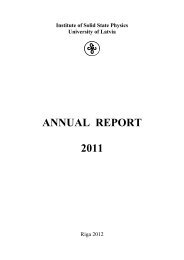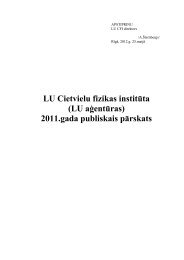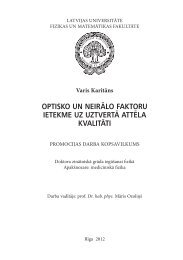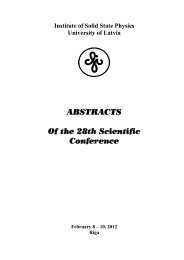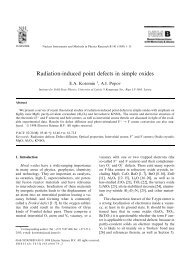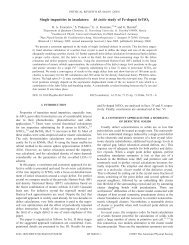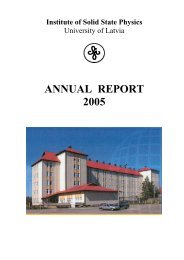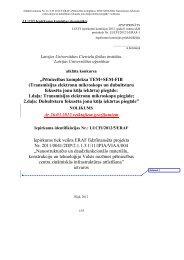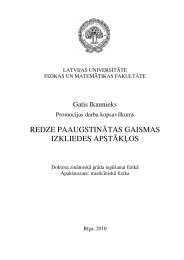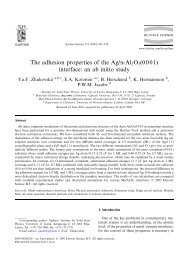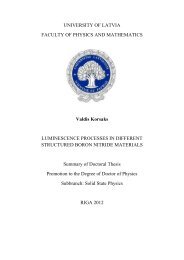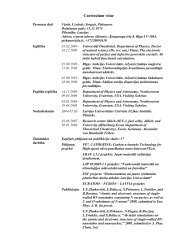Annual Report 2012 - Latvijas Universitātes Cietvielu fizikas institūts
Annual Report 2012 - Latvijas Universitātes Cietvielu fizikas institūts
Annual Report 2012 - Latvijas Universitātes Cietvielu fizikas institūts
Create successful ePaper yourself
Turn your PDF publications into a flip-book with our unique Google optimized e-Paper software.
LUMINESCENCE OF FUSED AND UNFUSED Bi-DOPED AMORPHOUS<br />
SILICA FABRICATED BY SPCVD<br />
Anatoly Trukhin*, Janis Teteris*,Aleksey Bazakutsa** and Konstantin Golant**<br />
* Institute of Solid State Physics, University of Latvia,<br />
LV-1063 Riga, Latvia<br />
** Kotel’nikov Institute of Radio-engineering and Electronics of RAS,<br />
Mokhovaya 11-7, Moscow, 125009, Russia<br />
Bismuth-doped high purity silica samples synthesized by surface-plasma chemical<br />
vapor deposition (SPCVD) are studied to investigate the origin of Bi-associated defects<br />
responsible for near infrared (NIR) luminescence. Two types of samples are studied:<br />
unfused Bi-doped silica film immediately deposited on the inner surface of a substrate<br />
silica tube and the same material after fusion obtained as the result of the tube collapsing<br />
to a rod by external heating. Luminescence is excited by pulsed UV (ArF – 193 nm, KrF<br />
– 248 nm) and green (532 nm) lasers. Luminescence bands centered at 620-650 nm, 808<br />
nm and 1400 nm wavelengths are observed in both fused and unfused samples. Orange<br />
and near-infrared luminescences excited by the green laser have decay time constant of<br />
about 3 µs for the 650 nm and of about 0.6 ms for the 1400 nm band at room<br />
temperature. Intensities of both bands do not depend on temperature in the 12 - 450 K<br />
range.<br />
STUDY OF PHOSPHORUS DOPED CRYSTALLINE AND GLASSY SiO 2<br />
A.N.Trukhin and J. Teteris<br />
Solid State Physics Institute, University of Latvia<br />
The main coordination of silicon in many materials, produced in “normal” pressure, is<br />
four. The α-quartz crystal, silica glass, different silicate glasses are example of those<br />
materials. However, in the case of glasses the density fluctuations with deviation of<br />
density to both directions higher and lower from “normal” are possible. Tetrahedron<br />
structure with sp 3 hybridization of silicon orbital allows wide range of fluctuations of<br />
density with creation of small rings. Example of dense tetrahedron structured silicon<br />
dioxide crystal is coesite with density gravity 2.915. Next modifications are related to<br />
principal change of silicon atomic orbital hybridization. High density fluctuation could<br />
be related to creation of sixfold-coordination silicon with d 2 sp 3 hybridization.<br />
phosphosilicate crystal (SiP 2 O 7 ), possesses mainly sixfold-coordinated silicon, then<br />
investigation of properties of that in phosphosilicate glasses should be performed for<br />
octahedron structure role clarification. Therefore we have studied samples of<br />
phosphosilicate glasses and samples of synthetic crystalline α-quartz doped with<br />
phosporus. Beside many differences in these samples we had found similar fast (40 – 60<br />
ns) ultraviolet luminescence excited in the range of 7.6 eV in them showing similarity<br />
with oxygen deficient luminescence of silica. So the possible explanation is proposed:<br />
the defect responsible for this luminescence is phosphorus stimulated sixfold<br />
coordinated silicon. Further investigations are needed.<br />
95



